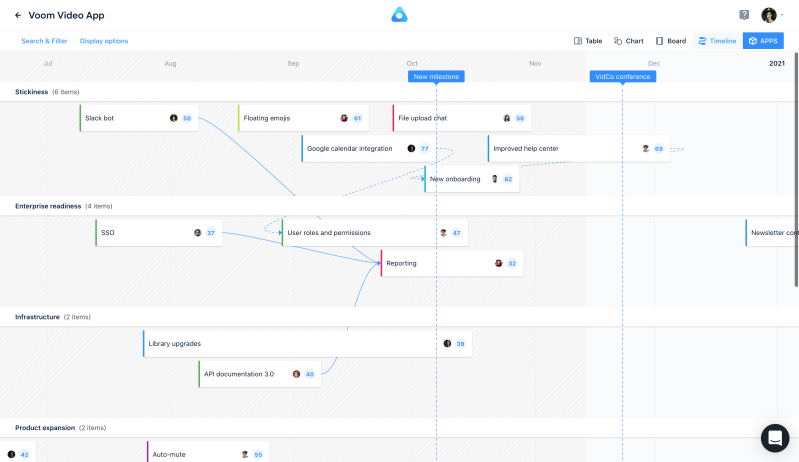1 Oct 2021
Roadmap Presentation 101: How to Present a Roadmap to Stakeholders
Communication, Relationships, and StakeholdersHave you ever gotten close to launching a feature...only to be surprised by unexpected stakeholder feedback?
Perhaps this new information caused you to delay?
Or waste effort and time?
Most of us product people have found ourselves in this unfortunate situation. Happily, this problem can be overcome with a bit of planning.
A well-thought-out product roadmap presentation will help you smoothly deliver against your product strategy.
Teams use roadmaps to communicate where we're going with our product. Product managers put tons of thought into them.
Roadmap delivery states are carefully considered. We ruminate over whether we communicate our roadmap in outcomes or features.
We deliberate over the merits of timelines in roadmaps (and hopefully opt against them!).
But to get the most out of our treasured product roadmaps, we need to get buy-in from our wider teams and stakeholders.

One important way to create buy-in is an effective product roadmap presentation to your roadmap to stakeholders. Presenting your roadmap to key stakeholders is a great opportunity to tell a compelling story about where you're going. It's a chance to align and validate your team's roadmap.
Thoughtfully present your roadmap and you will ensure your stakeholders can get behind your roadmap.
You will also reduce the risk of those nasty eleventh-hour surprises stopping you (and your product) in your tracks.
Before you go ahead with your next roadmap presentation, think about how you communicate your roadmap at these stages:
Before: get to know your stakeholders' needs and motivations. Anticipate questions and feedback that might come up in the presentation.
During: clearly communicate with your stakeholders and check-in for feedback.
After: continue to request feedback and iterate on your roadmap presentation.
What is a roadmap
Roadmaps are a common way of expressing product direction to teams.
They come in all sorts of different formats.
But one thing good roadmaps have in common is that they map where you're going with your product.
A roadmap provides a high-level overview of a product or project's vision and direction over time.

A roadmap serves several purposes:
It maps out your vision and strategic goals.
Details how you’ll deliver against that vision and strategy.
Communicates the necessary information to align stakeholders.
Sets your priorities so that you focus on what’s important.
What is a roadmap presentation
A roadmap is meaningless unless you can deliver against it.
This is why it's so important to create alignment with your sales team.
You want to make sure they are behind your roadmap so you can solve all the important problems you've prioritized!
A roadmap presentation is a communication and alignment exercise around key business metrics. It is part of your wider ongoing stakeholder management strategy.
The presentation shouldn't be the first time your stakeholders see your product roadmap. It should be part of an ongoing series of meetings or updates to communicate where your product is going.
The format and cadence of your roadmap presentation depend on your organization and stakeholders.
Some common types of updates are smaller check-ins as well as more formalized leadership presentations.
Smaller team check-ins
You might set up regular check-ins (e.g. weekly or bi-weekly) to talk about your roadmap with team members who are close to your product.
For example, if you are in a small startup, you may report directly to a CEO.
With a small check-in, you can regularly walk your CEO through your product roadmap every two weeks to ensure she has a firm grasp of where you're going.
These check-ins will give her the chance to feedback and ensure she is on board.
Another example is a regular check-in with the developers in your team. This sync will help them understand how their daily work fits into the bigger picture.
It will also give them the opportunity to feedback on the roadmap.
Recurring leadership presentations
Product managers also use more formal product roadmap presentations to communicate with leadership and other key stakeholders.
This is often the case in larger, product manager-led organizations.
These organizations likely have a well-established product practice and hierarchy.
Your organization may already have an agreed-upon roadmap presentation process for technical teams.
For example, your leadership team may ask that you present your roadmap at the beginning of each quarter, or each month.
This might be a more formal session with less room for back and forth, depending on time constraints.
In these types of meetings, concise messaging is critical. It is also important to have a clear view of your roadmap's impact on other teams, departments, and the wider organization.
This way, you are anticipating dependencies and cross-over between your product team, and other teams.
Why presenting your roadmap is important
Presenting your roadmap to key stakeholders is a great opportunity to tell a memorable and meaningful narrative and compelling story about where you're going.
It's a chance to bring to life your product roadmap artifact.
By presenting your roadmap to relevant business stakeholders, you can build alignment and validate your team's roadmap. This will help you and your team avoid:
Stakeholder confusion or dissatisfaction on where the product is going;
Conflicting messages from different stakeholders.
Last-minute stakeholder feedback and unanticipated surprises that might result in wasted effort;
A good roadmap presentation will ensure your stakeholders can get behind your roadmap. You and your team will feel confident that you have the right buy-in to deliver against your strategy.
How to present a roadmap
Preparing for your roadmap presentations
Think ahead about how you'll communicate your roadmap so that you can get the most out of your presentation. Your future self will thank you for putting in the time!
1. Ensure your roadmap aligns with the overall organization strategy and goals
Your roadmap should ladder up to your business’s strategy and goals.
Make sure you've put in all the work necessary to tally your product vision and roadmap up with the organization's strategy and goals.
Make it clear how where you're going is in line with where the business is going.

If your roadmap doesn't fit in with where the business is going, it's unlikely that you'll be able to get key stakeholders on board with it.
2. Identify your stakeholders’ interest and influence
Get a firm understanding of stakeholders' interests and influence on your product. This will help you communicate effectively with them.
Spend some time figuring who your stakeholders are, and mapping them out. A simple and impactful approach to this is the interest and influence matrix.
Stakeholder mapping will help you determine who you're communicating your roadmap with, and how to communicate with them.
Take time to think about who will be in the room (or call), and whether you have all the right people you need for buy-in. Review your stakeholder map to help you make decisions about the guest list beforehand.
If the right people are there, you'll be able to have a concise conversation and get the feedback and alignment you need.
3. Empathise with your stakeholders
Stakeholders have different goals, motivations, and challenges. Get to know your stakeholders before you hold your session.
This will help you understand them and create trust. Note that this is more relevant for more formalized leadership presentations. If you're presenting to a close team, you'll likely know those team members better already.
If you don't know your stakeholders before your session, set up some stakeholder interviews. This will help you to understand them. Stakeholder interviews can be informal. They're simply conversations to get to know stakeholders' motivations and challenges.
“Stakeholder interviews will help you understand the essential structure of the organization, how your work fits into the organization as a whole, and the approval process for various aspects of your project. They'll also provide you with some less obvious opportunities to influence your project's chances of success.” — Erika Hall, Just Enough Research
If you are very unfamiliar with your stakeholders, you can approach your conversations with more structure. Consider some guidelines to prepare for them.
4. Create buy-in with your stakeholders
You may already know stakeholders and their goals well.
Still, individual meetings are important for creating before your roadmap presentation.
This buy-in is most relevant for higher stakes leadership roadmap presentations.
Even if your roadmap presentation is more of an informal team sync, take the time to communicate your roadmap before the meeting to avoid surprises.
Early conversations will help you anticipate feedback and challenges that may come up in your presentation. It will also be useful to consider how your roadmap impacts on stakeholders and other parts of your organization. Listen actively to understand points of friction and potential pushback.
Aim to get stakeholders on board with your roadmap before your roadmap presentation. Remember that your presentation is to create alignment. You'll be far more likely to align with a wide group of stakeholders if you've created buy-in 1:1 beforehand.
During your product roadmap presentation
1. Set the agenda
I find it useful to spend time upfront being clear on the purpose of a session, and the format. Some areas to cover early on include:
Your roadmap presentation objective(s)
Outcomes you want to achieve with this roadmap presentation
The stage your team is at with your roadmap (are things largely defined at this stage, or is there ample opportunity for stakeholders to shape the roadmap at this stage?).
How you'll take feedback during the session, and outside of the session
You may also want to spend some time aligning on what a roadmap is. Don't assume that everyone knows! Tailor your message depending on the stakeholders you're speaking with and how product-led your organization is.
You can also cover any key principles that underpin your roadmap. For example, you may want to highlight to stakeholders that your roadmap is outcome-driven, rather than feature-driven.
Discussing what a roadmap is and its principles will create a shared understanding before you go into the artifact in more detail.
2. Communicate clearly and address your stakeholders’ needs
Using simple and clear language is a good bet in any setting. Avoid using industry jargon. Accessible language will go a long way to helping communicate your product roadmap. This is especially true if you're trying to align a wide variety of stakeholders.
Tailor your message depending on the audience. If you're speaking to leadership removed from your team's day-to-day, your message should be concise and to the point. If you're holding a more regular roadmap catch-up, you'll naturally want to cover more detail.
Be clear on the trade-offs you've had to make so that stakeholders get a good understanding of the different considerations you and your team make.
Give stakeholders the big picture so that they can understand where they fit in.
Remember to try and address your different stakeholders' needs. You may have uncovered these in earlier stakeholder interviews or catch-ups.
A good way to do this can be to filter your roadmap content by “epics” or outcomes. You can show the ones that are relevant to the departments or practices that you are speaking with.
3. Leave room for questions and feedback
One of the key goals of a roadmap presentation is to validate your roadmap with stakeholders.
Make sure you give participants an opportunity to ask questions and provide feedback. After all, alignment isn't one-sided! It's an exercise in negotiating different views and opinions.
Actively listen and hear people out. This doesn't necessarily mean you need to act on every single piece of feedback, but make sure stakeholders feel heard and understood.

What happens after the presentation?
Presenting your roadmap is part of your wider ongoing stakeholder management strategy. This means that once you've shared your product roadmap, things don't end there.
1. Make the roadmap artifact accessible
Create ongoing alignment by sharing your roadmap with stakeholders in an accessible place. This means putting it somewhere obvious where people can go and look at it regularly.
This will allow them to continuously check-in and keep up to date on changes. You should continue to communicate updates and changes to your roadmap outside of meetings. For example, you can update regularly using your company's messaging platform (e.g. Slack, Microsoft Teams) or other communication tools like Loom.
2. Follow up on feedback
Don't leave stakeholders hanging. Be deliberate about feedback on your roadmap. Make sure to follow up on any feedback shared during the presentation.
Also, consider creating a space where stakeholders can continue to provide feedback on your roadmap on an ongoing basis. Some ideas of how you can do this:
A shared document
A dedicated space in your company's knowledge sharing tool, if you have one (e.g. Notion, Confluence, Coda)
A dedicated channel in your company's messaging platform
A dedicated space for feedback in the roadmap artifact itself
Be sure to manage expectations on how this feedback will be reviewed and actioned.
3. Iterate on your product roadmap presentation
Get feedback from stakeholders on if your presentations and updates are working for them. This will help you improve and have better ongoing communication around your roadmap.
You may have been presenting product roadmaps in the same way for years but there is likely still room for improvement! Some areas you can seek feedback on:
Is the meeting cadence working for stakeholders?
Do they understand your product team's priorities and trade-offs?
Do they understand the roadmap's impact on them?
A roadmap presentation is a great way to align with stakeholders and get the buy-in you need to get on with delivering against it.
Roadmap alignment is a continuous, ongoing process. Be thoughtful about how you approach your roadmap presentations. Consider before, during, and after the roadmap presentation to build successful alignment.
How to create a winning product roadmap presentation with tips and examples
We know what a product roadmap presentation is. And we know why presenting your roadmap matters. But before we explore how to present a roadmap to stakeholders, let's look at how to build a powerful roadmap presentation with examples.
In this section, we'll use an example product that we have created a roadmap for — a project management platform for SMBs.
1. Define the goal and purpose of your presentation
One of the biggest mistakes you can make when creating a presentation for stakeholders? Overlooking the value of a clear goal and purpose.
You need to understand what you hope to achieve by the end of your presentation. Otherwise, you risk delivering a vague speech that leaves your audience confused or feeling like you're wasting their time.
Your goal and purpose may be to:
Convince stakeholders to support your new product or feature
Update your team on the latest feature to make sure they know why it matters and what their work will involve
Inform stakeholders of a new change in direction with an established feature and gain their approval
Let's say we want to add a video chat function to our project management platform. It will give our customers more flexibility to communicate and collaborate without leaving our platform to host video conferences elsewhere.
We want our presentation to highlight how this new feature will improve our platform and persuade stakeholders to green-light it.
With that goal and purpose in mind, we can structure the roadmap presentation to focus on the feature's benefits and secure the necessary support.
2. Understand the audience
Knowing who you're talking to and what matters to them is paramount to creating a successful roadmap presentation. If you're speaking to the people responsible for the budget, highlight key financial information. They want to know the costs involved, the potential revenue, and anything else that could affect the company's finances.
And tailor your presentation style and length to the people listening. For instance, a senior manager will likely be busy on any given day and appreciate a shorter, formal presentation that gets straight to the point.
3. Highlight the product vision
What's the most important part of your next product roadmap presentation anyway?
Let's give it the attention it deserves. Define your product vision in a way that excites stakeholders and wins them over. Explain your long-term goal for your product. What do you want it to be in, say, two years? Five years? Ten years?
For example, we want our example project management platform to become the only solution our customers need within three years. We want to be synonymous with successful project management and empower SMBs to unlock their full potential with streamlined features and cutting-edge functionality.
Whatever your product, keep your vision realistic, or you could lose credibility with stakeholders.
4. Explain and showcase the roadmap
Define your roadmap's value and determine the most effective way to present that information. Our project management platform roadmap is a comprehensive plan that delivers all the details our stakeholders need to understand why they should support it.
Go through the roadmap's key points clearly and honestly. Put yourself in the stakeholders' shoes and consider what you'd want to hear. Incorporate visuals (see below) to add context, clarity, and inspire stakeholders' imaginations.
5. Use visual product roadmap aids
The best, most successful presentations feature visual components to reinforce their points and boost their persuasive power. But only use visuals if they're clear and easy on the eye. Two points to consider:
Use colors to distinguish different areas of your roadmap (like blue for our platform's low-priority features, red for high-priority ones).
Avoid adding too much visual information to your presentation. Focus on presenting essential details and explain the rest to boost engagement.
Never add visuals as an afterthought, though. Always make sure they add value.
6. Create a clear CTA
Do you know exactly what you want stakeholders to do after your presentation (e.g. provide funding)?
You should create a compelling call to action (CTA) that propels them toward that goal. Your CTA should be simple, concise, and inspirational. If your presentation is engaging enough, a well-written CTA should be irresistible.

Hilary Johnson

Read also
Experience the new way of doing product management






